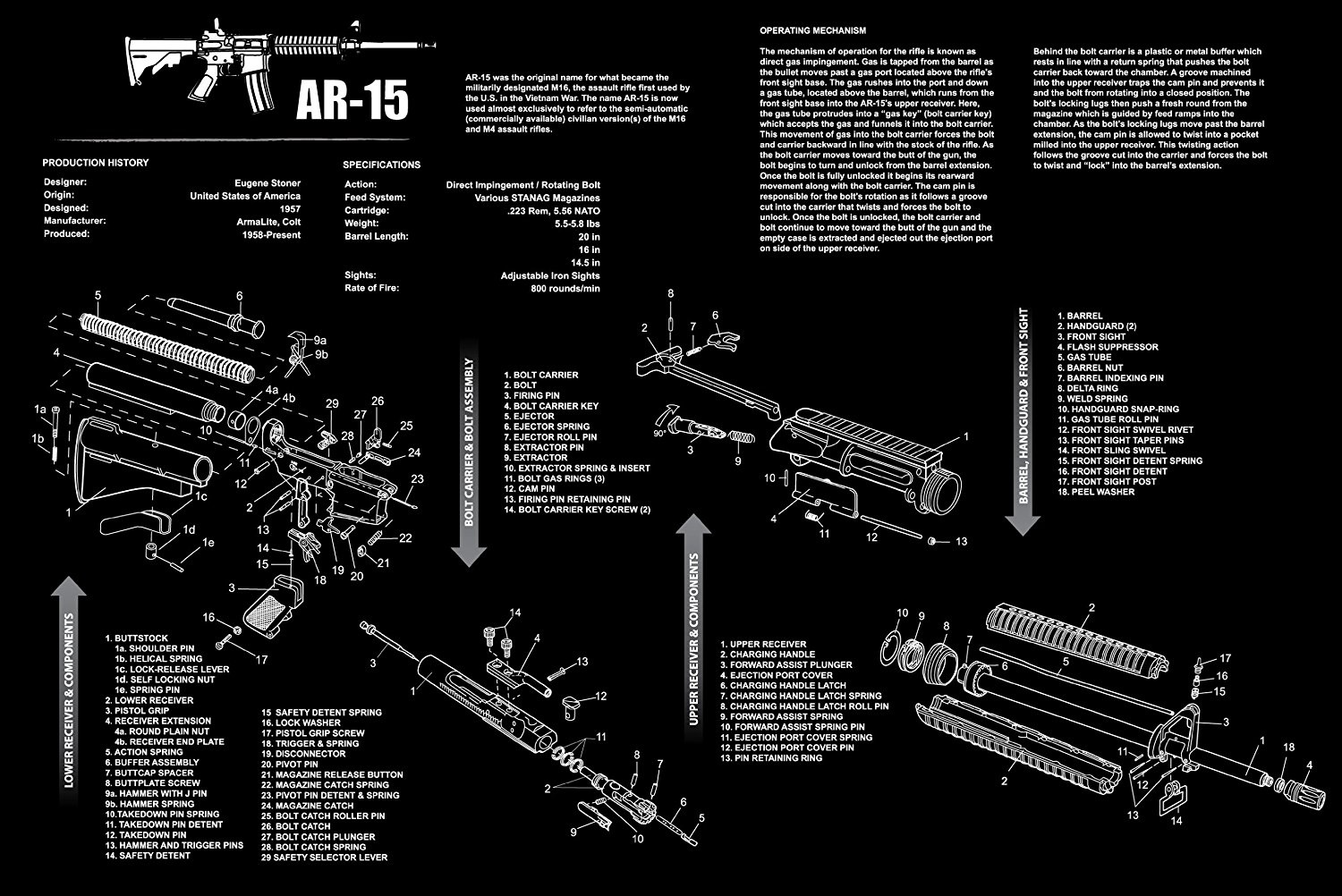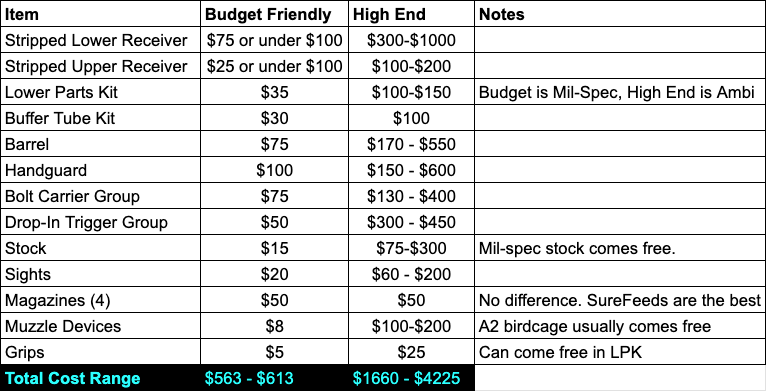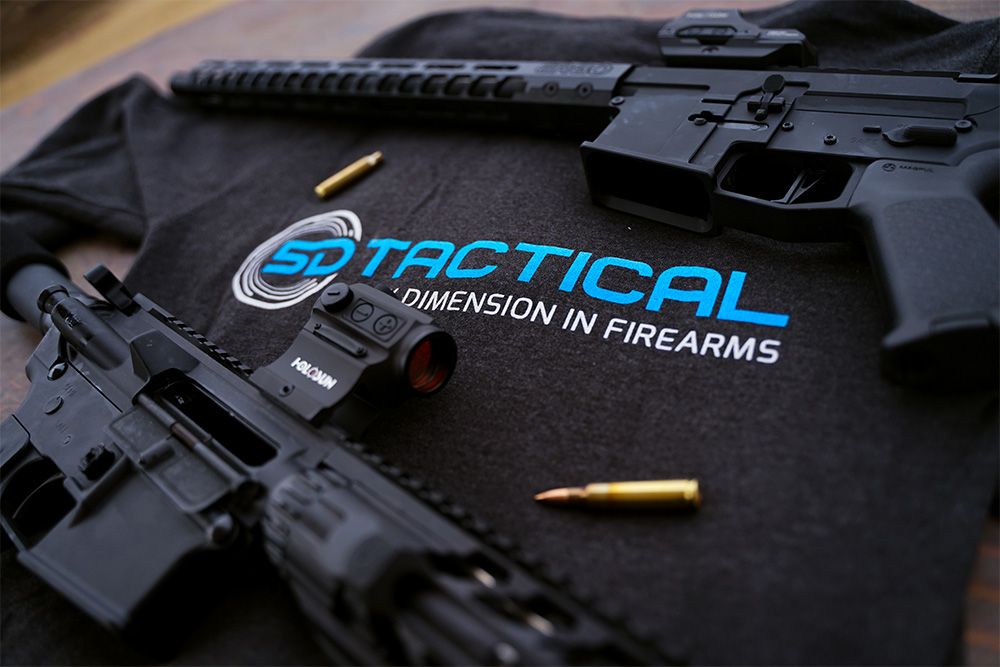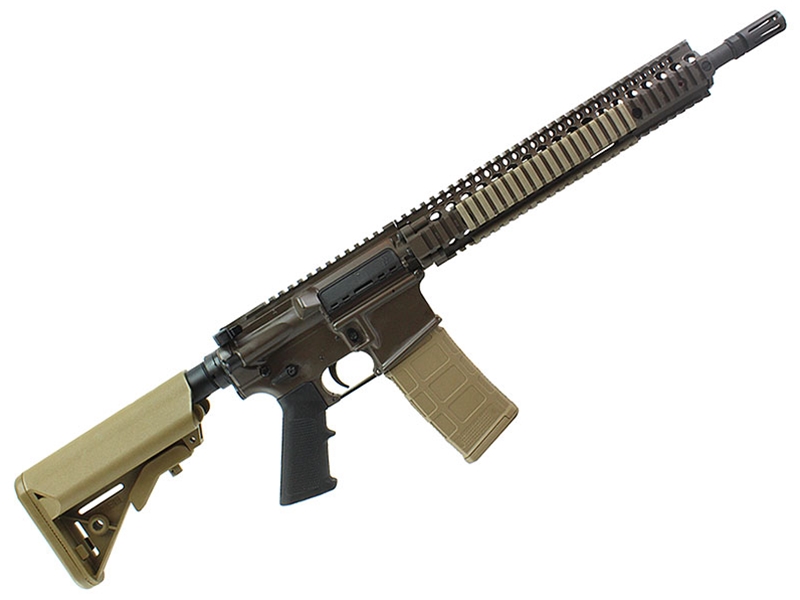How Much Does it Cost to Build An AR15?
The AR-15, highly customizable and immensely reliable, is one of the most popular choices among gun enthusiasts considering a DIY project. However, understanding the cost to build an AR-15 is paramount before embarking on such a venture. This guide discusses the expenses associated with constructing an AR-15. It examines various price ranges and their impact on the firearm's quality and functionality.
How much does it cost to build an AR15? It depends on your budget. It may fall under a sub $1k category or extends beyond $4k for a more high end firearm with comprehensive accessories. This guide will help you navigate your AR-15 build.
How much does an AR15 cost?
Building an AR-15 involves an array of components, each contributing to the total cost. In this discussion, we will focus on the key components of AR15s, their significance, and the typical cost associated with them. This will help us determine an approximate average price. But if you want to build a race gun, check this blog out instead.
Lower Receiver
The lower receiver is the foundation of your AR-15, housing the trigger and fire control group. This component is legally the firearm, so it requires a federal firearms license (FFL) to purchase. The cost of AR15 varies from about $75-$100 for a budget friendly lower but can go from $300-$1,000 for high-end stripped lower receivers.
Now for those of you who want to truly create your own AR-15, there's nothing better than building out an 80% lower (and you don't have to deal with an FFL). As long as you live in a state where 80% lowers are legal you can truly create your own rifle from the comfort of your home.
Completing your lower at home will require more effort and a higher initial cost. This includes doing the work and buying the necessary tools. You can purchase a lower for $100 or a Freedom builders kit with a jig, router, hardware, and lower for as little as $471.
Upper Receiver
The upper receiver accommodates the barrel, barrel shroud, bolt carrier group, and charging handle. This component directly affects your AR-15's performance. Budget-friendly upper receivers can range from $25-$100, while high-end versions can cost $100-$200
We can commonly find completed uppers that contain all the components we listed above. Completed upper receivers can range from $250-$400 for your more budget-friendly options and can climb just above $2-3,000 for your boutique marksman style complete uppers.
Barrel
A key determinant of your AR-15's accuracy, the barrel's price depends on its length, material, method of rifling, and twist rate. You can find budget-friendly barrels for as low as $75. Those high-end match grade barrels made from carbon fiber can run north of $900.
Most people opt for fantastically high end barrels that barely touch the $300 mark. Remember, in most cases, a barrel under 16” is by the letter of the law and SBR. You can build out an AR pistol to enjoy the shorter barrel length and increased maneuverability to circumvent that.
Handguard
Responsible for keeping your hand off the barrel full of hot gas. The handguard can cover as much or as little of the barrel as you would personally prefer.
Depending on the materials and manufacturer there is a definite difference in price points. Your budget-friendly handguards can be had for around. The high-end handguards will range from $150 to $600. If you want to know more in-depth about some different handguards such as M-LOK vs Keymod - we have a blog dedicated to just that.
Bolt Carrier Group
Responsible for seating your round to be fired and extracting the case after the rounds have been shot. You're going to be able to find budget-friendly options for as low as $75 while the BCG's with more premium coatings will range from $130 to $400.
Trigger Group
Your trigger group directly impacts your shooting experience. Consisting of both the trigger and hammer as well as the miscellaneous housing components that allow it to fit snuggly in the lower. A lighter trigger makes shooting easier, but some people like the heavier triggers used by the military and law enforcement.
Trigger groups are one of the few parts that a more expensive group has an immediate impact on the shooting experience. You can find trigger groups for as cheap as $50 but for $190 you are able to have a drop-in trigger with a light trigger pull (seen as a pull under 4.5 lbs). If you have even more to spend companies do offer world changing triggers for about $300 - $450.
Stock
This can be broken down into the parts that make up the stock but unless you already have a buffer tube, buffer spring, and buffer weight. It is much easier, in the beginning, to pick up a stock assembly. It contains all the parts and hardware needed to attach it to your lower. You can find a buffer tube kit for $50-$70 with higher-end stock assembly from $160-$300.
Additional AR-15 Components and Accessories
Beyond the necessary components to make your AR-15 go bang. There is a plethora of aftermarket options to make your AR truly your own!

Photo Credit: 101 Diagrams
Sights
Optics and sights are always a hot commodity. You can get dedicated long-range optics for $5000+ and you can pick up a pair of iron sights for $50.
The world of optics is incredibly varied and truly boils down to personal preference. Traditional iron sights are analog, robust, and won't run out of batteries. Red dots will get the job done by providing quick target acquisition but hitting anything past 100 yards will be a tough feat without a good bit of range time. LPVOs are popular optics in recent years and are my personal favorite to use.
The breakdown of budget-friendly optics across all types ranges from $50-$300 for an extremely low-end LPVO. Your high-end optics' pricing can shoot to the moon. They range from $1000-$5000+
Magazines
Fiercely debated across the United States between pro and anti-gun legislators. Magazines are simply what hold the ammo and feed the rounds into the firearm after each trigger pull.
The standard capacity is 30 rounds in your AR-15 but you can find magazines that only hold 5-10 if you live in a state that hates freedom and drum mags that can hold 60 rounds. The material and prices vary but there are really only two groups of magazines people consider. Polymer magazines like Magpuls or Hexmags and the metal military STANAG/GI style.
They both do the same job and hold the same number of rounds and have similar price points. Standard metal and polymer magazines cost around $15-$20 per magazine. The more ammo you want to hold the more expensive the mag gets. However, the inverse isn’t true…
Muzzle Devices
An AR-15 isn't complete without a muzzle device, which helps control the recoil, muzzle rise, and noise signature of the firearm. These essential components come in a variety of designs including flash hiders, muzzle brakes, compensators, and suppressors each with a unique set of benefits.
A budget-friendly yet effective option is the A2 flash suppressor, which comes standard on many AR-15 rifles. It's reliable, reduces muzzle climb, and suppresses flash reasonably well, making it a solid choice for budget builds. These cost $10.
As for your high-end muzzle devices, the price range is immense. You can go for a muzzle brake or compensator from just about any company it will run about $100-$130. Or, you can go ham and get a muzzle device that can mount a suppressor. That will extend your cost to close to $1500 including the $200 tax stamp and other fees (especially if it's your first time).
Pistol Grip
The grip of your AR-15 greatly influences the handling and ergonomics of your firearm. It's where your hand meets the rifle, and comfort is key.
For budget build, you can get very inexpensive grips that typically come with your lower parts kit. The kits are $70 but the grips individually cost around $20. As for your high-end builds, you can pick up grips for $50-$100
Comparison of the Cost of Building vs. Buying an AR-15
General AR15 Cost Range Chart. Photo Credit: 5D Tactical
The choice between building your own AR-15 and buying a pre-assembled one often boils down to personal preference, your budget, and the desire for customization. Let's compare the cost implications of both choices to help you decide which path is most suitable for you.
If you're considering going the route of building your own AR-15, one of the key benefits is the ability to customize your rifle to your exact specifications. Depending on your selection of parts and components, building an AR-15 could cost anywhere from $500 to $3,000 or more. Remember, this cost can be spread out over time, allowing you to slowly acquire parts as funds become available.
Building Your Own AR-15
Photo Credit: 5D Tactical
Building your own AR-15 offers an unmatched level of customization and the pride of creating your own unique firearm. The cost can range from $500 to over $10,000, depending on the specific components and accessories you choose.
Pros of Building Your Own AR-15
- Complete control over the selection of components, allowing for a high degree of customization.
- Potential to spread out the cost over time as you gradually acquire components.
- Sense of satisfaction and accomplishment from building your own firearm.
Cons of Building Your Own AR-15
- Can be time-consuming and requires a certain level of mechanical skill and knowledge.
- Costs can add up quickly, especially if you opt for high-end components.
- Need for specialized tools, which can add an extra $100-$200 to your total cost if you don't already own them.
Buying a Pre-built AR-15
Photo Credit: RifleGear
Buying a pre-built AR-15 is a straightforward option that gets you a reliable firearm with less time and effort. Depending on the brand and model these entry level rifles can cost between $500 to $3,000+. Just look at the Daniel Defense AR15 in the image above — this particular model is running a mil-spec trigger, muzzle device, and even pistol grip at the price of $2249 before sales tax!
Pros of Buying a Pre-built AR-15
- Convenient and time-saving, with no assembly required.
- Assurance from professional assembly, reducing the risk of errors.
- Immediate use right out of the box, perfect for beginners or those needing a firearm quickly.
- Complete rifles don't require much work done to them.
Cons of Buying a Pre-built AR-15
- Fewer customization options compared to building your own.
- High-end, pre-built models can be expensive, and you're also paying for the labor and expertise of assembly.
- Potential additional costs for upgrades or changes to the standard configuration.
One thing to keep in mind is that you normally don't get an optic with a pre-built AR-15 and will have to purchase it separately increasing the cost at the end of the day.
Tips for Saving Money on Building an AR-15
Building a high-quality AR-15 on a budget may seem challenging, but knowing where to allocate your funds effectively can lead to significant savings. Here are some tips to help you build a reliable, durable AR-15 without breaking the bank.
1. Be Strategic with Your AR Build
The most crucial aspect of your build is the AR-15 itself. Brands like BCM, Daniel Defense, Colt, and Spike's Tactical are known for their quality and are worth investing in. Consider buying a complete upper from a reputable manufacturer and building your own lower with a high-quality lower parts kit. Most of the AR's reliability lies in the upper, so be sure to choose a quality upper and bolt carrier group.
2. Sights
One easy way to save is to stick with the standard front sight base. It's not only cost-effective but also adds to your AR's reliability. For the rear sight, consider a fixed rear sight if you're going to mount a red-dot optic. Fixed sights from manufacturers like Troy or LaRue can be a rugged and more affordable alternative to folding sights.
3. Hand Guards
Handguards can be a substantial expense. It's essential to remember that handguards serve to mount a sling, a light, and potentially a hand stop or vertical grip. Standard handguards are the most budget-friendly option while still maintaining functionality.
4. Trigger
Stick with the standard fire control group that came with your quality rifle or lower parts kit. A standard trigger, while not as crisp and light as a match trigger, is usable, durable, and reliable.
Building an AR-15 with 5D Tactical
In summary, building your own AR-15 gives you the chance to create a firearm tailored to your exact needs and preferences. We appreciate you taking the time to go through our broken-down cost considerations, comparison of the benefits of building versus buying an AR-15, and strategies for cost-effective, yet quality builds.
Whether you are looking for budget-friendly options or high-end components, 85D Tactical provides a range of quality parts, kits, and accessories to cater to your specific needs.
Embark on the rewarding journey of building your own AR-15 with 80 Percent Arms. We invite you to explore the possibilities and take your firearm craftsmanship to the next level. For more guidance, check out our related build blog posts, or dive straight into our range of parts and accessories. Start your build today and experience the satisfaction of assembling your own AR-15.






